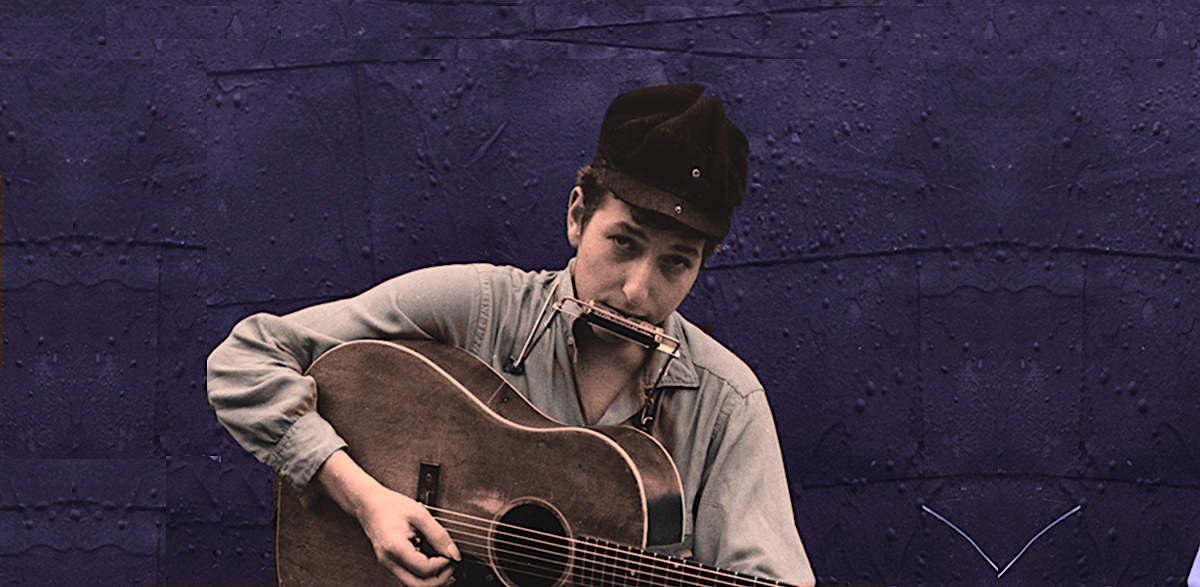Advanced level English
► For vocabulary guide, see below.
► See also IELTS-style reading comprehension test on this text
If you're a bright and restless teenager in a small town in the American Midwest, you may well have one desire, and that is to get out, to go somewhere else. Hibbing, Minnesota, is one such town, and Robert "Bob" Zimmermann was one such young man.
In 1959, at the age of 18, Zimmermann left Hibbing to study English at the University of Minnesota in Minneapolis; but formal studies were not his thing. Bob was very much into folk music, and on campus and off it, soon became a popular performer at folk clubs and folk events. "Zimmermann" was a bit of a long name for a cool folk singer, so Bob adopted the name of the popular radical Welsh poet Dylan Thomas, who had died six years previously. Robert Zimmermann became Bob Dylan.
Big though it was, compared to Hibbing, Minneapolis was not the throbbing cultural capital of the United States, and within a year Bob had dropped out of university and made up his mind to pursue a career in music instead. It was a pretty big gamble; the terms "folk singing" and "career" rarely went together, and there were hardly a dozen successful folk singers in the USA at the time; there was the ageing Woody Guthrie, the popular Pete Seeger, and the folksy Brothers Four. But Bob, now reborn as Bob Dylan, had talent, had a particular musical style, and an ambition to go with it.
From Minneapolis, Dylan made his way to the heart of the contemporary American folk music scene, Greenwich Village in New York, reaching the city by Greyhound Bus in January 1961 with little money in his pocket and no clear career plan in his head. It was however the start of a new chapter in his life, and at once he began performing in local clubs, gaining attention for his talent and unique style.
Performing in the coffeehouses and bars of Greenwich Village, playing both popular folk songs and some of his own compositions, Dylan soon built up a following. His distinctive nasal voice and original lyrics attracted the attention of music critics and fellow musicians. And just over three months after he arrived in New York, an enthusiastic article in The New York Times by Robert Shelton helped launch Bob Dylan on the road to success. Within weeks Columbia Records had signed him up for a recording contract.
Dylan's first album, simply titled "Bob Dylan", came out in March 1962, and included a mixture of traditional folk songs such as the House of the Rising Sun, and a couple of Dylan's own compositions. The album was a success, but just a foretaste of what was to follow. It was Dylan's second album "The Freewheelin' Bob Dylan", released in 1963, that really revealed his unique genius as a songwriter. It came out at a point in time when J.F.Kennedy was President of the USA, America was getting involved in Vietnam, and people were alarmed at the prospect of nuclear war. Songs like Blowin' in the Wind and A Hard Rain's A-Gonna Fall touched on the developing issues of the day.
The 1964 album The Times They Are a-Changin' continued the trend with socially conscious protest songs that captured the mood of a generation increasingly politicized by the civil rights movement, the Vietnam War, and youthful rebellion against social conformity. Protest music was Dylan's specialty, and as the sixties wore on he became the unofficial voice of the youth counterculture movement.
It was in this role that the following year Dylan was billed as the top act at the July 1965 Newport Folk Festival, the biggest annual folk event in the USA. At the time there was a clear distinction between folk music, using acoustic guitars, and a new genre called rock 'n' roll, or more generally pop music, which used newly introduced electric guitars. Newport was for folk fans, not rock 'n' roll fans, so when Dylan broke with tradition and brought a backing group with electric guitars onto the stage to perform Maggie's Farm and Like a Rolling Stone, it caused uproar. Traditional folk fans cried "traitor" and tried to boo him off stage... but they failed to convince.
The audience should have known what to expect, as three months earlier Dylan had already "gone electric" with his fifth album Bringing It All Back Home. Younger and more avant-garde fans liked what they heard, and their hero's crossover from traditional folk to a kind of folk rock was widely applauded. Venturing into new creative fields had become one of Dylan's hallmarks.
However, Bringing... was only the beginning of Dylan's creative evolution. His next album Highway 61 Revisited would be hailed by many as his masterpiece, featuring some of the greatest lyrics ever written These included the momentous Desolation Row, almost twelve minutes of lyrical meandering through a dystopian world populated by Cain and Abel, Einstein, Ezra Pound and other figures from our collective culture. It was Dylan at his best, the Dylan that 51 years later would be awarded the Nobel Prize for Literature.
From 1965 to 1967, Bob Dylan was the most influential poet and singer in the world, rivalled only perhaps by John Lennon. In 1966, he undertook a massive world tour involving 47 concerts, the last two being in Paris and London. Two months later, everything came to a halt; speeding along a rural road in Woodstock, New York, Dylan was involved in a serious motorcycle accident. He was not killed – indeed within a year he had returned to the recording studio – but Dylan had changed. There was still the same nasal voice, still the folk songs, still the electric guitars, but the magic had gone.
Since 1967, another twenty-eight albums have followed, most recently in 2020, and to this day Dylan is still recognised as a great musician. But as an icon his time is well past.
WORDS
throbbing: beating, pulsating - gamble: risk - fellow musicians - other musicians like him - foretaste: example - trend: direction - was billed: was announced - uproar: a noisy reaction - traitor: someone who betrays a cause or another person - hallmark: defining characteristics - dystopian: orderless, crazyCopyright © Linguapress. Do not copy this document to any other website
Copying permitted for personal study, or by teachers for use with their students
STUDENTS' WORKSHEET - printable
The early years of Bob Dylan
Interactive exercise. Use on screen or on paper
Comprehension Questions: Answer these questions in your own words.1. Where was Bob Dylan born and raised, and what was his original name?
2. What led Bob to adopt the name "Bob Dylan"?
3. Describe the initial challenges Bob Dylan faced when becoming a folk singer.
4. How did Bob Dylan's arrival in Greenwich Village contribute to his rise to fame?
5. How did Bob Dylan's first and second albums help establish his musical identity?
6. Explain the social and political context that influenced Bob Dylan's music during the 1960s.
7. How did Dylan cause a controversy at the 1965 Newport Folk Festival?
8. What impact did the motorcycle accident in 1966 have on Bob Dylan's career and musical output? For teachers
These questions cover a range of cognitive levels, from recalling basic facts to analyzing and interpreting the text. They should help assess students' understanding of Bob Dylan's life, career, and influence.





 Copyright
information.
Copyright
information.